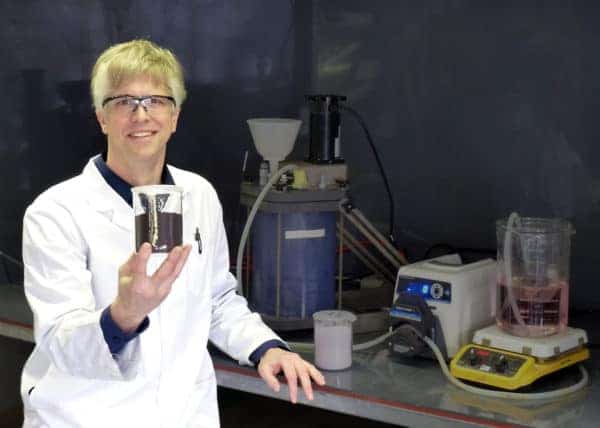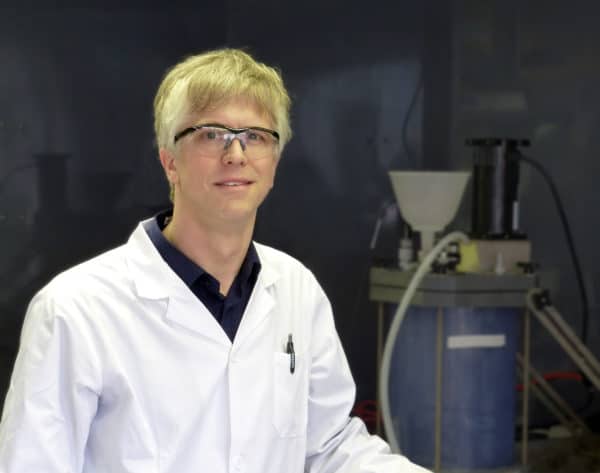

It’s 2016 and electric vehicles are, dare we say it, sexy.
Formerly the domain of nerds and futurists and awkward endorsers like Ed Begley Jr., Tesla now brings to mind bold and dashing glamour. Maybe that’s because celebrities like George Clooney, Leonardo DiCaprio and Mark Ruffalo drive one. Or maybe it’s because the company’s founder is the real life inspiration behind Tony Stark.
Tesla’s rise to prominence is a clear signal of a generational shift that has finally begun. But there’s one big problem: batteries. Tesla may have changed the electric car forever, but on the equally mammoth task of tackling the performance and reliability of the battery, the company gets something less than an “A” grade. Why? For that answer, we turn to Fred Schlachter from the American Physical Society in the Proceedings of the National Academy of Sciences.
“There is no Moore’s Law for batteries,” Schlacter told Scientific American recently. “The reason there is a Moore’s Law for computer processors is that electrons are small and they do not take up space on a chip. Chip performance is limited by the lithography technology used to fabricate the chips; as lithography improves ever smaller features can be made on processors. Batteries are not like this. Ions, which transfer charge in batteries are large, and they take up space, as do anodes, cathodes, and electrolytes. A D-cell battery stores more energy than an AA-cell. Potentials in a battery are dictated by the relevant chemical reactions, thus limiting eventual battery performance. Significant improvement in battery capacity can only be made by changing to a different chemistry.”
Enter Canada’s Nano One Materials Corp. (Nano One Material Corp. Stock Quote, Chart, News: TSXV:NNO). The upstart company has already demonstrated startling success by focusing on manufacturing technology for the production of lithium ion battery cathode materials. The result of the company’s work, longer lasting batteries made from lower cost energy storing materials, is gaining traction and winning endorsements from thought leaders in the space and promises applications far beyond the electric vehicle space. Cantech Letter sat down with the company’s founder and CEO to talk about the progress it has made over the last year and what is next.
Dan, it’s been a year since we last talked to you. What has Nano One been up to since?
It’s great to talk to you again Nick and it has been a busy year. We have new patents, we’ve been building our team, we’ve been advancing our cathode materials and we have been awarded federal funding to pilot our technology at a larger scale.
Let me provide a little more detail. To start, Nano One has been granted three patents since last summer, that cover processing, materials and batteries. Also, our team grew with the addition of Dr Stephen Campbell in 2015 as Principal Scientist. Stephen has 25 years of automotive fuel cell expertise from Ballard and Daimler Benz Ford Joint Venture AFCC, where he also held the role of Principal Scientist. Our cathode materials offering has grown to include strategically important materials and we anticipate interest from industry players as we begin the pilot project. Our scale up plans have also advanced with the completion of design concepts on a full scale commercial cathode facility and we have now launched design and construction of a pilot plant to demonstrate scalability.
Progress on these fronts led to the approval of $2-million in non-dilutive support from Sustainable Development Technology Canada towards the pilot project and we have other funding proposals underway with the Federal Government. It promises to be another busy year.
Our commercialization strategy is to license and/or partner with an industry player. Success on this requires strong patents and line-of-sight to cost effective full scale production.
Do you feel Nano One is advancing towards commercialization?
We are definitely moving the needle on commercialization. As you know, Nano One has a unique approach and is focused on manufacturing technology for the production of lithium ion battery cathode materials. Our commercialization strategy is to license and/or partner with an industry player. Success on this requires strong patents and line-of-sight to cost effective full scale production. To this end, we were granted three patents this last year and SDTC has validated and approved $2M in funding towards our commercialization efforts. As noted already, we are working in collaboration with Noram and we’ve launched the design and construction of a pilot plant to demonstrate scalability. Alongside of these advances, we have also been making a wider range of cathode materials than ever and strategic discussions continue.
How would a successful commercial rollout happen for you? You wouldn’t, as a software company might, make a big sale with a perpetual license…what would the onset of success look like from the outside?
With regards to commercialization, we remain convinced that a licensing strategy is the shortest path to success. Our intellectual property package will give partners a competitive edge and an engineering package should pave the way for rapid adoption and commercialization. This approach is low on capex, leverages commercialization expertise of established players and it circumvents barriers to entry. Our technology certainly has appeal to value add players in cathodes, batteries and electric vehicles but it could also unlock value for lithium producers. I think we are already seeing the onset of success but this would be furthered with strategic collaboration on supply chain or battery validation.
We’ve had validation on several fronts including batteries, patents, due diligence, conceptual design studies. We’ve tested battery materials with third party battery players and confirmed the positive outcomes with Canada’s National Research Council.
Can you tell us more about your collaboration with Noram Engineering?
We’ve been increasing our collaboration with Noram Engineering and their subsidiary B.C. Research over the last 18 months. They add valuable expertise in commercialization, process engineering and electrochemistry. Early this year, we completed the conceptual design of a ten-ton per day cathode plant and now we have launched design and construction of a lithium ion battery cathode material pilot plant. This will be used to demonstrate cost, scalability, performance and novelty of Nano One’s technology to third party strategic interests. This work will also add know-how, patents, and equipment to Nano One’s offering. Given the rising demand for lithium, electric vehicles and energy storage, this is a great time to be forging valuable relationships like the one we have with Noram.
Do you see more partnerships or agreements like the one with Noram in the future?
As the pilot takes form, we anticipate that other players will join the consortium to validate the technology and test the resulting cathode materials. We could easily see agreements that focus on materials testing, licensing, co-development, joint venture or commercial partnerships. The range of possible partners extends across the value chain from mining to cathodes, batteries and electric cars.
We are seeing rising demand with record highs in the lithium space. This in turn is driving demand for technology, such as Nano One’s, to unlock the benefits of nanomaterials.
Can you talk a bit about the ways your technologies and processes have been validated?
We’ve had validation on several fronts including batteries, patents, due diligence, and commercial concepts. We’ve tested battery materials with third party battery players and confirmed the positive outcomes with Canada’s National Research Council. Our first three patents were granted in relatively short order since we last spoke. There were only minor revisions to the patents and this validates the exclusivity of our technology and its commercial significance in the battery space. Due diligence by government funding agencies such as SDTC and IRAP have also provided endorsements of our technology and commercialization plans. Lastly, collaborative work on the commercial scale concepts has provided Nano One with the knowledge and framework to move forward with piloting.
Let’s talk about the big picture a bit. What is driving the demand for nano materials?
People get excited about nanomaterials because they have valuable magnetic, optical, mechanical or electrical properties. If one can harness these benefits for commercially viable applications, then it can create the kind of demand we are seeing for battery materials. The demand for portable electronics, electric vehicle and greener energy storage is driving demand for batteries and the nanostructured lithium based materials within. As an aside, we seem to be at an inflection point in energy storage, because conventional wisdom would have demand for electric vehicles dropping with oil prices, but instead, we are seeing rising demand with record highs in the lithium space. This in turn is driving demand for technology, such as Nano One’s, to unlock the benefits of nanomaterials.
The electric vehicle market is already driving battery manufacturing volumes and the energy storing materials that go into them. Progress on this front will spill over to stationary energy storage as the cost, supply chain and adoption challenges are addressed.
If electric vehicles are the current biggest driver of demand for your technologies what is next? Will there always be a demand for smaller particles or do you envision it reaching a peak at some point?
The electric vehicle market is already driving battery manufacturing volumes and the energy storing materials that go into them. Progress on this front will spill over to stationary energy storage as the cost, supply chain and adoption challenges are addressed. What batteries really need are longer lasting, higher density, lower cost energy storing materials. Particle size isn’t a big driver but what is important is the underlying structure and composition of the cathode particles and the methods used to make them. Improving the process of making these materials can address all of these needs and is the rationale for Nano One’s unique approach to bettering the battery.
Nano One was just approved for a $2-million grant from Sustainable Development Technology Canada. What will this money allow you to do?
The $2-million will be non-dilutive and non-repayable and will help fund the design, construction and operation of a pilot plant. The pilot will be able to produce various lithium ion battery cathode materials on the scale of tens of kilograms suitable for use in electric vehicle, grid storage and consumer electronic batteries. The pilot plant will be used to showcase Nano One’s patented technology and demonstrate cost, scalability and performance to third party strategic interests. SDTC is one of the largest clean-tech funds out there and this is a tremendous endorsement of our technology, team and commercialization plan. SDTC’s process put us through rigorous due diligence over the last year and they are very supportive of their portfolio companies so its a privilege to have earned their confidence.
Disclosure: Nano One is an annual sponsor of Cantech Letter
Leave a Reply
You must be logged in to post a comment.






 Share
Share Tweet
Tweet Share
Share




Comment